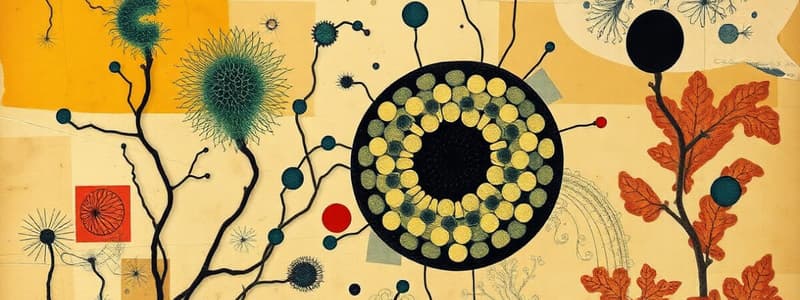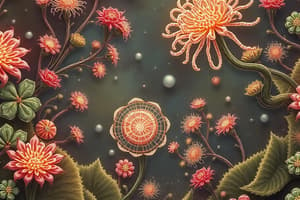Podcast
Questions and Answers
What is a key difference in the reproduction methods between prokaryotes and eukaryotes?
What is a key difference in the reproduction methods between prokaryotes and eukaryotes?
- Prokaryotes reproduce by fragmentation.
- Eukaryotes reproduce asexually only.
- Prokaryotes do not engage in sexual reproduction, while eukaryotes do. (correct)
- Prokaryotes use mitosis for reproduction.
Which structural feature distinguishes eukaryotic flagella from those of prokaryotes?
Which structural feature distinguishes eukaryotic flagella from those of prokaryotes?
- Prokaryotic flagella have no structural function.
- Eukaryotic flagella are shorter.
- Prokaryotic flagella contain 9+2 structure.
- Eukaryotic flagella contain a characteristic 9+2 structure. (correct)
Which of the following accurately describes algae?
Which of the following accurately describes algae?
- Algae possess specialized vascular bundles.
- Algae are only unicellular organisms.
- Algae are photosynthetic organisms without specialized root or stem structures. (correct)
- Algae develop through an embryo stage.
What role do red algae (Rhodophyta) play in marine ecosystems?
What role do red algae (Rhodophyta) play in marine ecosystems?
Which of the following statements is true regarding prokaryotes?
Which of the following statements is true regarding prokaryotes?
What is a common characteristic of red algae?
What is a common characteristic of red algae?
How do prokaryotes differ from eukaryotes in terms of nuclear division?
How do prokaryotes differ from eukaryotes in terms of nuclear division?
Which statement accurately describes nitrogen fixation among organisms?
Which statement accurately describes nitrogen fixation among organisms?
Flashcards
Prokaryotic Cell Wall
Prokaryotic Cell Wall
Typically contains peptidoglycan.
Eukaryotic Nuclear Division
Eukaryotic Nuclear Division
Usually occurs through mitosis or meiosis.
Prokaryotic Flagellum
Prokaryotic Flagellum
Does not have a 9+2 structure when present.
Algae Diversity Range
Algae Diversity Range
Signup and view all the flashcards
Algae Specialized Structures
Algae Specialized Structures
Signup and view all the flashcards
Algae Reproductive Stage
Algae Reproductive Stage
Signup and view all the flashcards
Red Algae (Rhodophyta)
Red Algae (Rhodophyta)
Signup and view all the flashcards
Algae Carbon Storage
Algae Carbon Storage
Signup and view all the flashcards
Study Notes
Prokaryotes vs. Eukaryotes
- Prokaryotes:
- Cell walls typically contain peptidoglycan.
- Nuclear division occurs without a nuclear membrane.
- Chromosome is not enclosed in a membrane.
- Asexual reproduction is common; sexual reproduction (in some bacteria).
- Flagella, when present, lack a 9+2 structure.
- Some can fix nitrogen (e.g., bacteria and blue-green algae).
- Eukaryotes:
- Cell walls lack peptidoglycan.
- Nuclear division usually occurs via mitosis or meiosis.
- Chromosomes are enclosed within a nuclear membrane.
- Sexual reproduction is common.
- Flagella, when present, have a characteristic 9 + 2 structure (9 outer and 2 inner).
- Most cannot fix nitrogen (e.g., all other plants and animals).
Algae Characteristics
- Algae diversity ranges from tiny unicellular microalgae to large seaweeds.
- Algae are photosynthetic organisms.
- They can be unicellular or multicellular.
- Algae lack specialized roots, stems, and vascular bundles.
- Algae lack a diploid embryo stage and surrounding sterile tissues.
- Zygote development uses mitosis or meiosis, not embryo formation.
Rhodophyta (Red Algae)
- Abundant and diverse in warm tropical and subtropical areas.
- Found in temperate and polar seas (some in hot springs).
- Critical to coral reef building (encrusting, calcified corallines).
- Involved in carbon storage—carbonate deposits containing calcium carbonate in cell walls.
- Deepest photosynthetic eukaryotes (over 210 meters in the Bahamas).
- Some species are parasitic on other macroalgae.
- About 6,000 species; mostly marine, some freshwater, and very few terrestrial.
- Color comes from pigments like phycoerythrin and phycocyanin (pinkish in marine, bluish in freshwater).
Batrachospermum sp.
- Found in clear, cold running fresh water streams.
- Deep water species are dark violet or reddish.
- Shallow water species are olive green.
Red Algae Thallus
- Thallus (body) of red algae is delicate compared to brown algae.
- Motile forms are absent, even reproductive cells are non-flagellated.
Red Algae Morphology
- Most red algae have multicellular, macroscopic, and diverse thallus forms.
- Uniaxial: Axis formed by a single row of filaments.
- Multiaxial: Axis formed by more than one row of filaments.
Cell Wall Structure
- Plant cell walls contain two main parts:
- Fibers of cellulose: Rigid, glucose polymer.
- Gels of polysaccharides: Flexible, sugar polymer.
Red Algae Plastids
- Red algae plastids come in two general types:
- Axial/Stellate: Examples are Porphyridium with a large, central plastid.
- Parietal/Discoidal: Examples are Audouinella with multiple small plastids.
Floridean Starch
- Red algae store carbohydrates as floridean starch.
- It is different from starch in land plants (Lacks amylose; branched structure called amylopectin).
Pit Connections
- Most cells in red algae do not completely divide.
- The open region is eventually plugged with proteins.
- These are considered ordinal level taxonomic characters (core and cap morphology).
- There are primary and secondary pit connections.
Red Algae Reproduction
- Red algae reproduce vegetatively (cell division, fragmentation) or asexually (monospores).
- Many red algae taxa exclusively rely on vegetative and/or asexual reproduction.
Studying That Suits You
Use AI to generate personalized quizzes and flashcards to suit your learning preferences.




